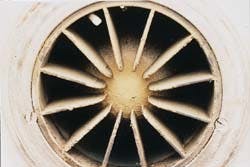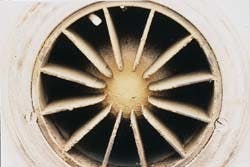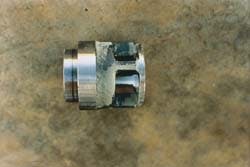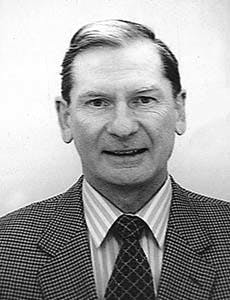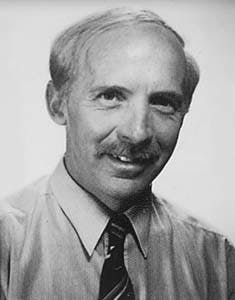TECHNOLOGY S 8 threatens natural gas operations, environment
Andre-Bernard Chesnoy
Hydrocarbons Production Consultant
Paris
David J. Pack
Gas Measurement Consultant
Perth, W.A.
A 200-mm ANSI 600 turbine meter is coated with elemental sulfur (Fig. 1).
Elemental sulfur coats a pressure-control valve quick-opening cage (Fig. 2).The presence of elemental sulfur (S 8) in natural-gas can have serious consequences for gas production, processing, and pipeline operations.
Yet, no reliable means exist to analyze a gas stream for its presence.
Elemental sulfur within a gas stream can be costly not only because of equipment damage and resulting poor reliability, but also because of extensive plant downtime.
S8 has been found to affect the accuracy of flow-measuring instruments, to damage turbine blades because of passage of loose S8 particles, and to cause severe plugging of exchangers.
To compound this matter, burning S8 forms sulfur oxides which leads to sulfuric acid rain when these oxides are emitted into the atmosphere.
The kinetics leading to S8 are not well understood and need further investigation. Submitted here are several proposals whose adoption by operators could lead to a better understanding.
Although other forms of elemental sulfur exist, such as S2 and S6, discussions here center only on S8.
Sulfur in natural gas
Sulfur in natural-gas transmission and distribution networks can present a variety of problems, not just for the operator but also in particular cases, the consumer.
Sulfur-bearing molecules in natural gas are well known and have been traced essentially as hydrogen sulfide (H2S), carbonyl sulfide (COS), and mercaptans (RSH). Wet produced natural gas combined with carbon dioxide (CO2) and H2S constitutes a highly acidic environment.
Of major and universal concern is corrosion. It has been found that in aqueous systems, mild and low-alloy steels can be corroded with catastrophic rates (20 mm/year) at room temperature, if in direct contact with elemental sulfur.1
It has been behind several blow-outs and petrochemical plant disasters in the world. Current progress in stainless-steel alloys permits better control over corrosion.
In refining, high-cost catalysts have been poisoned and deactivated by sulfur compounds. Progress in defining new catalysts and appropriate preprocessing have permitted the operation of facilities with accurate control.
Able to react with inorganic and organic substances, sulfur is found in several molecular forms and, like nitrogen, has a large number of oxidation states. This means the sulfur cycle is chemically complicated.
One element of this cycle not under good control is S8. Its chemical kinetics of formation from other molecules is not well known and the unusual phase change from gas to solid states in gas transportation is not thoroughly understood.
The concentration of sulfur compounds in natural gas can differ significantly, depending on the production field and the subsequent processing. Small quantities of sulfur compounds, such as H2S and/or COS, can lead to serious corrosion.
It has been witnessed that a few ppm of H2S in the gas stream can, through localized chemical and/or thermodynamic reactions, present difficult operational problems to the pipeline operator at given locations, even though adjacent sites or the remaining system show no such problems.
Identification, observations
Within a gas-transportation system, usually a high-pressure transmission pipeline, the generation of S8 can occur under a range of operating conditions. These conditions will be influenced by:
- Gas composition
- Types of additives used within the pipeline, for example, glycols and odorants
- Operational parameters of the pipeline, particularly pressure-reduction facilities
- Internal condition of the pipeline, coated or uncoated
- Gas plant gas-purification process and equipment types
- On-line maintenance procedures.
The list of the chemical reactions leading to sulfur formation and an evaluation of the free energy for each reaction is given in Table 1 [30704 bytes].
The phenomenon of S8 generation in natural-gas transportation is not isolated to a few cases, nor is it associated with any particular gas fields or processes.
Several European gas-pipeline systems and facilities have experienced it, and in some of these cases the result has been considerable impairment of operations.2
In Australia, the generation of S8 within at least two major transmission pipelines, served from independent gas fields, has been observed.
It is somewhat surprising that in this advanced stage of gas treatment, most sales-gas contractual specifications still center on CO2 and H2S contents.
There are good reasons for this:
- CO2 has an important impact on the Wobbe index, supercompressibility, and to a lesser extent, corrosion.
- H2S is readily quantified according to a number of well-established procedures.
- H2S is extremely dangerous; it induces stress sulfur-cracking corrosion and is highly toxic even at low concentrations.
- S8 presence has not been suspected for long: while extremely difficult to quantify, it is not considered a direct safety hazard.
Thus even today, whereas most gas-pipeline operating companies have on-line analyzers such as gas chromatographs for H2S and CO2, there are no on-line analyzers for S8.
Some companies, using a split-sample stream, convert by hydrogenation all sulfur components to H2S in order to measure an overall H2S equivalent, but this does not answer the real question regarding S8.
Experiment
To help understand the mechanism for sulfur deposition within a transmission system, an experiment was initiated to see if S8 deposition occurred at subsonic flows.
To achieve this, a nozzle with a 2.4-mm throat diameter was placed in a line connected to a high-pressure natural gas pipeline at a point some 825 km downstream of the main gas supply.
The outlet of this test line vented to atmosphere through a throttling plug valve. Upstream of the nozzle was placed an instrument valve for pressure adjustment.
For subsonic flow through a critical flow venturi nozzle the Mach number is given by:
Mt2 = (2/k-1)[(P1/P3)k-1/k - 1]
where:
Mt = Mach number at the nozzle throat
P1 = Pressure upstream of the nozzle
P3 = Pressure downstream of the nozzle
k = Isentropic exponent
The mass flow rate of the gas flowing through the nozzle is given by;
m = A2{(2k/k-1) P1r1 [(P2/P1)2/k - (P2/P1)k+1/k]}0.5
where:
m = Mass flow rate of gas through the nozzle
A2 = Cross sectional area of nozzle throat
r1 = Density of gas upstream of nozzle
P2 = Pressure of gas in nozzle throat
Note: for subsonic flow, P2 = P3.
The test was conducted for 42 hr with an estimated average mass flow rate of the gas through the nozzle of 0.044 kg/s. Therefore, total mass flow for the period of the test is estimated to be some 6,650 kg. The gas being used for this test was not odorized.
If the H2S in the gas supply were 1 ppm (typical analysis value for period under test), then the potential mass of H2S within the 6,650 kg flow would be 12.1 g.
Assuming the following reaction takes place, then 11.4 g of sulfur could be expected to be formed from the complete transformation of H2S.
CO2 + H2S ' CO + H2O + S
It was noted at the end of this test that the throat of the sonic nozzle had a light deposition of sulfur around the lower 60% of its circumference. It must be appreciated that some of the sulfur would most likely remain in the gas stream and be vented to atmosphere.
The purpose of referring to this experiment is not to quantify any process but to demonstrate that sulfur deposition occurs at certain conditions and that it appears to be pronounced. The experimental conditions are given in Table 3 [22622 bytes].
As well as the deposition of elemental sulfur in the throat of sonic nozzles, other observations within pipeline systems have included the deposition around pressure control valves, which can affect the stem movement or plug the valve orifice, the coating of all internal pipe fittings, including pipe walls, thermowells and straightening vanes, and flow meters.
The deposition of S8 on turbine meters has been observed to introduce a measurement error of up to 2%, and in some cases even more.3
Compressor stations associated with transmission pipeline systems have also been found to be susceptible to S8 deposition.
Kinetics of elemental sulfur
Elemental sulfur is a solid at normal temperatures, having a melting point of 112.8° C. for the rhombic allotropic form.
To help comprehend the sulfur cycle from wellhead to consumer, the operation and types of equipment used within the gas treatment process need to be understood.
As already stated, sulfur compounds can usually be readily found at the source of the natural-gas supply. What happens to these sulfur compounds then depends upon the processing and to some extent on the composition of the natural gas.
For example, high concentrations of CO2 in the gas supply will favor formation of COS and reduction of H2S. This COS will not be detected by the lead-acetate-rate method of monitoring.
The operation of molecular sieves, as used by gas-processing plants, also warrants some attention in the understanding of the sulfur cycle associated with the treatment and transportation of natural gas.
As molecular sieves show a high adsorptive selectivity for polar and unsaturated compounds, they are in common use at gas-processing plants for gas-purification applications. H2S, SO2, COS, CO2, and water are all polar compounds.
Water is a very strongly adsorbed impurity, whereas CO2 is one of the more weakly adsorbed impurities of natural gas. Of course the adsorption characteristics depend on the molecular sieve type in service.
The molecular sieves can adsorb small molecules while excluding larger ones. Therefore, this characteristic can be used to achieve separations based on molecular size differences.
One of the problems relating to the use of molecular sieves for processing natural gas containing H2S and CO2, is the formation of COS according to the reaction H2S + CO2 , COS + H2O.
According to Kohl, the COS formed is not strongly adsorbed and therefore appears in the treated gas long before H2S appears.4 This problem can also be encountered in molecular-sieve beds performing primarily as dehydrators.
It has also been noted that H2S in the feed gas to solid-bed dehydrators can cause difficulties, particularly if the gas also contains traces of oxygen. In the latter case, the desiccant acts as a catalyst for oxidation of H2S to S8 which deposits on the sieve aggregate.
Some of this is vaporized during regeneration and can cause plugging of cooler condensers,5 but large amounts of S8 in flakes can be carried away down the transportation network.
Sulfur burned in atmosphere
As already discussed, elemental sulfur can easily be transported from the gas pipeline pressure-reduction facility to gas customers' premises.
For most industrial applications, natural gas is used as a primary energy source. Therefore, through direct firing, the burning of the elemental sulfur will produce sulfur according to the reaction S8 + 8O2 ' 8SO2.
This sulfur dioxide (SO2) will then usually be part of the industrial emission into the atmosphere.
Unfortunately, the chemical reactions do not stop here because once into the atmosphere the SO2 can be oxidized to SO3.
Either from the SO2 or SO3 state, a further reaction can take place with the water vapor or water droplets in the atmosphere to form sulfuric acid H2SO4, according to the following reactions:
SO2 + H2O + [O] ' H2SO4
SO3 + H2O ' H2SO4
In the last 25 years, four important trends are noteworthy in European energy:
- 1. Overall natural-gas consumption increased by 389% from 90 billion cu m in 1973 to 350 billion cu m in 1996.
2. Natural gas as a fuel source for electricity generation increased from 115 Tw-hr in 1973 to 278 Tw-hr in 1995.
3. Oil as a fuel source for electricity generation has been reduced from 397 Tw-hr in 1973 to 240 Tw-hr in 1995.
4. Following the denunciation of coal as responsible for severe SOx emissions, its use is now mainly industrial, with significant emission improvements having been achieved by installing flue-gas cleaning equipment. (SO2 emissions have been reduced by a factor of five.)
In spite of the positive trends as regards SO2 and NOx emissions by industrial users, the period has witnessed serious impact on the foliage of large forests of northern Europe which could not be related to any specific accident or gas-line leakage.
A "guesstimate" for northern Europe alone where about 650 MM normal cu m of gas is burned each day on average shows that 1 ppm (vol) of S8 would lead to the formation of 20 metric tons/year of sulfuric acid.
In good probability this is not happening permanently, but there are most probably times when the S8 content is multiplied by 10 or 50 fold on occasion of upset in the transportation systems.
At times, some gas terminals in the North Sea have experienced the complete plugging by sulfur of their facilities.
There is no doubt that in the long term, the trends observed in Europe will cause a general abatement of SO2 and NOx emissions. It is important, however, to recognize that S8 in a number of instances has been disseminated in gas networks, and it has been identified particularly at processing and metering facilities.
When gas containing unsuspected S8 is burned in power generation (10% of the overall natural-gas consumption in Europe and nearly 21% for Australia), the resulting SO2 may be controlled.
But when the same gas passes to domestic distribution networks, nothing stops or controls its transformation to SO2 and release to atmosphere.
Certainly the contamination scale is not at the same level with coal or fuel oil, yet if a new step is to be made towards an additional abatement of SO2 emissions, the tracking of S8 existence or formation in natural-gas transportation is necessary.
Mitigating actions
The deposition of elemental sulfur within natural-gas transportation systems results from a process called "desublimation."
This occurs when there is a direct condensation of a vapor to the solid state without appearance of a liquid phase. Therefore, the mitigation required is control of the necessary conditions leading to desublimation.
To eliminate the formation of elemental sulfur within the natural-gas transportation system, two important factors must be controlled: the rate of cooling of the gas and the state of the entrainer of quench.
The rate of cooling would normally be a function of the pressure drop generated by the pressure-regulating equipment. For the situation under study, the state of the entrainer or quench substance appears to be CO2.
According to Perry, the rate of change from the gas phase to the solid phase is determined by the rate at which heat is removed from the gas phase and from the solid phase that is subsequently formed.6
It is interesting to note that at the observed field locations where S8 has been found, the gas stream and hence the entrainer (CO2) are at conditions in which CO2 is at or very near conditions (pressure, temperature) where its density (mol/l.) has a significant step change. Table 4 [35209 bytes] gives examples of these conditions.
From the field trials undertaken using a 2.4-mm nozzle, as described previously, it can be seen that sonic velocity is not necessarily a prerequisite for the deposition of S8.
Fig. 3 [27951 bytes] is a plot of the change of physical state of CO2. The field conditions observed for the formation of S8 are in good agreement with the pressure and temperature values as derived from the points on the CO2 physical state curve (Fig. 3).
For the set of observations obtained, the conditions immediately upstream of the nozzle just happened to satisfy the step-change density criteria for the entrainer (CO2).
It would appear, therefore, based on the limited observations and tests undertaken, that to ensure conditions for S8 deposition do not occur, the rate of cooling (degree of pressure reduction) of the gas flowing across a pressure-reduction stage needs to be controlled, together with the gas conditions (entrainer condition) immediately upstream of the pressure reduction.
Limiting S8 formation
If the presence or appearance of S8 downstream of a gas-treatment terminal can only be related to the oxidation of other sulfur compounds, there are but two ways to limit S8 formation:
- 1. Further eliminate the sulfur compounds at the gas treatment terminal.
2. Prevent the oxidation process of S atoms to S8.
In such a way all sulfur-bearing molecules will be cracked and sulfur atoms will be hydrogenated to H2S. The next step consists in eliminating H2S.
Gas-processing licensors, such as UOP, Des Plaines, Ill., Institut Francais du Petrole (IFP), Rueil-Malmaison, France, Union Carbide (UC), Danbury, Conn., and Imperial Chemical Industries (ICI), London; offer a variety of nongenerative and regenerative processes, and the choice hinges on two major specifications:
- H2S inlet gas concentration
- H2S outlet gas specification.
An elegant regenerative process calls for molecular sieves. Good selection of the sieve dimension and optimum control of adsorption front breakthrough are keys to success. This will give feasible results for H2S inlet concentrations of up to 100 ppm.
There are several gas-treatment plants using this process in the world. Its danger is that if the gas in addition to H2S also contains CO2, some molecular sieves will catalyze the formation of COS according to CO2 + H2S , COS + H2O.
If the COS produced meets moist gas downstream, it will hydrolyze back to H2S.
Should the H2S concentration approach the percent level, the Claus process is about the only answer. ELF of France at Lacq has mastered a process handling 25% H2S in the inlet gas.
Amine wash has been for many years the predominant sour-gas process. And in North America, optimization studies have led to selecting alkanoamine for gases containing both CO2 and H2S.
Regarding the second method for limiting S8 formation, oxygen scavenging, it has been observed in research centers that even small amounts of oxygen will considerably activate the mechanism of H2S oxidation to S8.
Thus, oxygen levels must be kept below 5 ppm in facilities where the sour gas is either treated or transported.
All forms of air ingress through compressor seals, instrument lines, and purging operations must be avoided. The elimination of other molecules bearing oxygen atoms (CO2, COS) may have to be considered because they will react readily with H2S to release S8.
Investigations required
Confronted by the unexpected presence of solid sulfur in their facilities, some gas-transportation companies have attempted to carry out an overall sulfur balance.
The results are deceiving because some analytical equipment and procedures are not adapted to the problem of S8 evaluation.
Clearly, further studies need to be undertaken with regard to this important phenomenon. It cannot only have very undesirable operational consequences for natural-gas pipeline operations, gas-processing plants, and gas customers, but also highly undesirable environmental effects.
The interrelation between the pressure reduction and hence rate of cooling on the gas, together with the action of the entrainer, needs to be more clearly understood.
This interaction needs to be fully documented for all gas-transportation conditions. This will require more extensive field trials and simulation studies.
However, the solution should not be an expensive nor unobtainable operation. Simple reconfiguration of field pressure-reduction facilities should resolve the situation, provided all contributing factors have been carefully accounted for.
It is unlikely that a simple temperature adjustment or pressure change undertaken in isolation would provide a reliable long-term solution.
It has been observed by several gas-transportation operators that under specific conditions, S8 will go from the gas phase to a solid phase causing detrimental deposits affecting the accuracy of instruments. It can also contribute to severe exchanger plugging, and loose chunks of S8 deposit can damage turbine blades.
Yet the overall understanding of the phenomenon is incomplete. Several investigations would help, namely:
- The construction of a dependable industrial on-line S8 analyzer
- A thorough investigation of factors influencing the kinetics of the set of reactions leading to S8
- Evaluation of the conditions influencing desublimation and the quenching of the gas mixture.
References
- 1. Schmitt, G., "Effect of Elemental Sulfur on Corrosion in Sour Gas Systems," Corrosion Vol. 47, No. 4, 1991.
2. Chesnoy, A-B. "Critical Venturi Nozzles Meter Natural Gas," ISA/93, Instrument Society of America International Conference.
3. Pack, D.J., and Edwards, T.J., "Improvements in Flow Measurement Uncertainty for a Natural Gas Transmission System," Flomeko '93. 6th International Conference on Flow Measurement, Seoul, October 1993.
4. Kohl, A., and Riesenfeld, F., Gas Purification, Fourth Ed., Gulf Publishing Co., Houston, 1985, p. 654.
5. Kohl, A., and Riesenfeld F., Gas Purification, p. 667.
6. Perry J.H., ed., Chemical Engineers' Handbook, Fourth Ed., McGraw Hill International Editions, pp. 17-25.
7. NIST Standard Reference Database 4, 1992; Thermophysical Properties of Hydrocarbon Mixtures, Strapp, National Institute of Standards & Technology, Gaithersburg, Md.
8. Atkins, P.W., Physical Chemistry, Fourth Ed., Oxford University Press, p. 135.
9. Gas World International, April 1996. p. 32.
The Authors
Andre-Bernard Chesnoy is a petroleum engineering consultant for Total S.A., Paris. He has also held positions with Monsanto (U.S.), Lummus (U.S.), and Union Carbide Europe. Chesnoy holds a diploma as Ingenieur Civil des Mines (1964) and an MSChE (1967) from Washington University, St. Louis. He is a senior member of ISA.
David J. Pack is a manager for Gas Measurement & Auditing Pty. Ltd., Perth, and a registered professional engineer (CPEng.) with post-graduate qualifications in engineering and management.
Copyright 1997 Oil & Gas Journal. All Rights Reserved.
